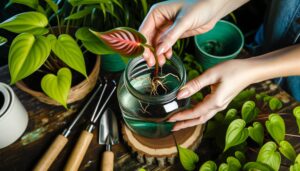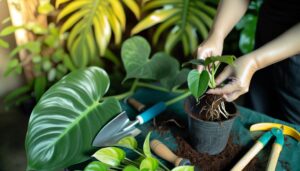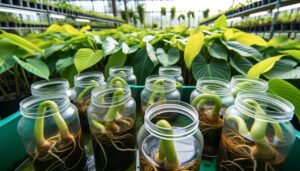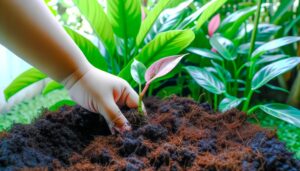Heart Leaf Philodendron Propagation in Water: Tips!
Successfully spreading Heart Leaf Philodendron in water involves selecting healthy cuttings, preferably 4-6 inches long, with at least two nodes essential for root development. Utilize sterilized pruning shears to make a clean cut just below a node.
After removing lower leaves but retaining a few at the top, immerse the cutting in a transparent container filled with distilled or filtered water. Replace the water every 5-7 days to maintain oxygen levels and monitor root health for signs of browning or rot.
Adequate lighting and regular water changes promote best growth. Further details will ensure thorough propagation knowledge.
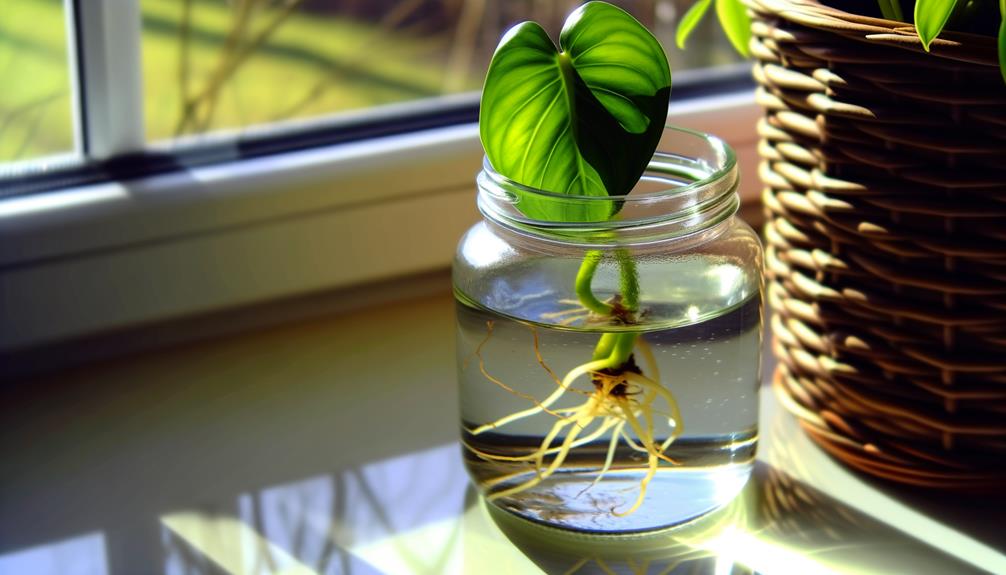
Key Takeaways
- Select healthy, 4-6 inch cuttings with at least two nodes for rooting.
- Use sterilized pruning shears to make a clean cut just below a node.
- Remove lower leaves, leaving one or two at the top for photosynthesis.
- Submerge cuttings in distilled or filtered water, ensuring nodes stay underwater.
- Change water every 5-7 days to maintain oxygen levels and prevent stagnation.
Choosing Healthy Cuttings
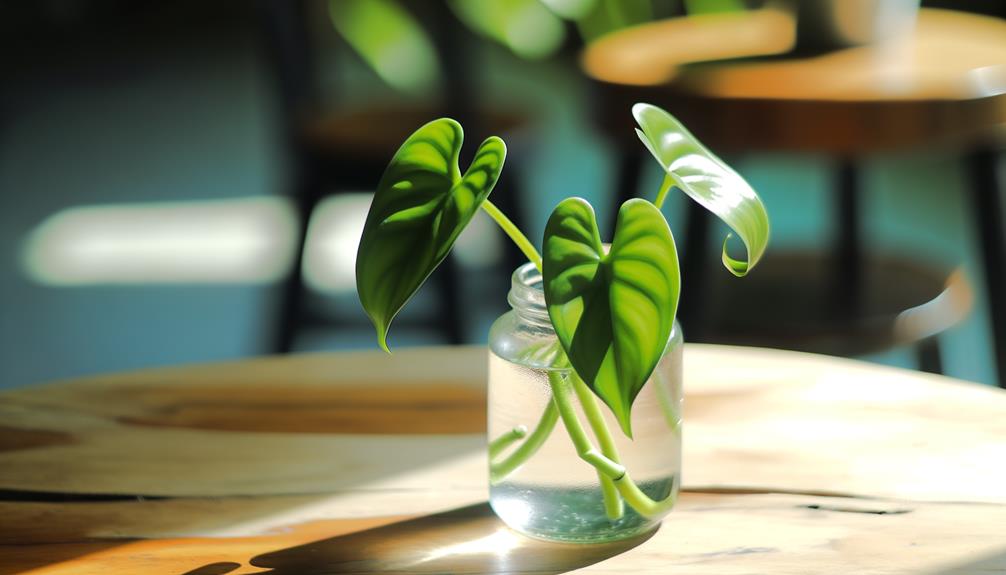
To guarantee successful spread of heart leaf philodendron in water, it is vital to select cuttings that exhibit robust health and vigor. Prioritize stems that are neither too young nor overly mature, ideally 4-6 inches in length with at least two nodes. Nodes are critical as they are the origin points for root development.
Examine the foliage for signs of chlorosis, pests, or disease; only choose those with vibrant, unblemished leaves. The stem should be firm and free of soft spots or discoloration. Utilize sterilized pruning shears to make clean cuts just below a node.
This methodical selection process ensures best cellular activity and nutrient transport, greatly enhancing the likelihood of successful root initiation and subsequent growth.
Necessary Tools and Supplies
After selecting the best cuttings, gather the necessary tools and supplies to create a sterile and suitable environment for propagation. Essential items include sharp, sterilized pruning shears to guarantee clean cuts, reducing the risk of infection.
Use a transparent container, preferably glass, to monitor root development. Choose distilled or filtered water to prevent chlorine and other contaminants from hindering growth.
Additionally, prepare rubbing alcohol or a bleach solution for sterilizing tools and containers. Make sure you have paper towels for drying tools and a small, clean workspace. Labeling materials, such as waterproof markers and labels, can help track propagation progress.
These tools and supplies are fundamental to maintaining optimal conditions for successful heart leaf philodendron propagation.
Cutting the Stem
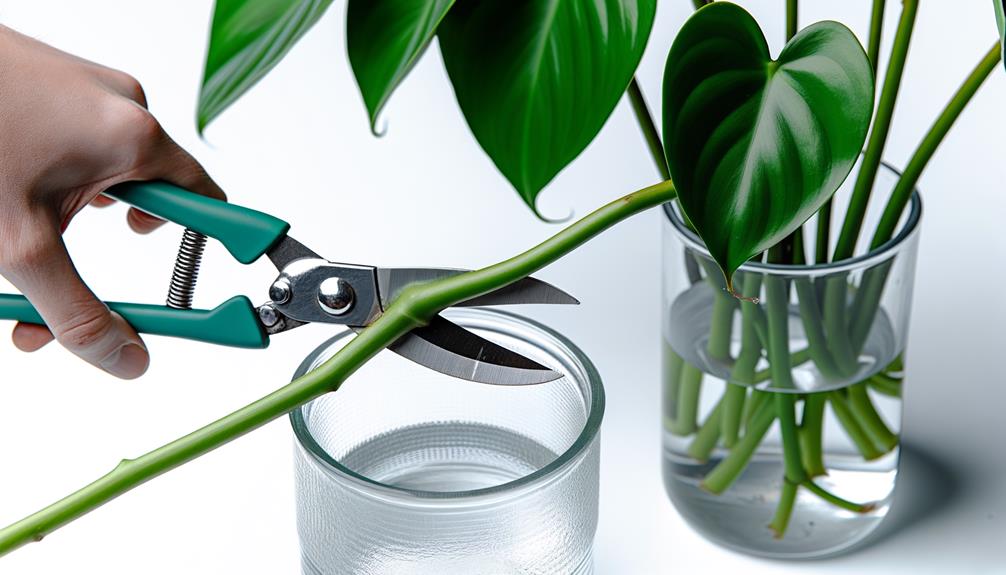
Begin by identifying a healthy stem that features at least two to three nodes, as these are essential for successful root development. Make sure that the selected stem is free from disease and damage, exhibiting vibrant green coloration.
Utilize sterilized pruning shears to make a precise cut just below a node, maintaining a clean incision to prevent pathogen entry.
Follow these steps:
- Select a suitable stem: Check it has 2-3 nodes and is healthy.
- Sterilize tools: Clean pruning shears with rubbing alcohol.
- Make the cut: Position shears just below a node and cut cleanly.
- Inspect the cutting: Verify the cut is smooth and free from fraying.
This methodical approach supports the best conditions for root initiation.
Removing Lower Leaves
Carefully remove the lower leaves from the cutting, making sure that at least one or two leaves remain at the top to facilitate photosynthesis.
Employ sterilized scissors or pruning shears to make clean cuts, minimizing tissue damage and reducing the risk of pathogenic infections.
The removal of lower leaves is vital as leaves submerged in water can decay, leading to bacterial growth and compromised root development.
Observations indicate that maintaining a few leaves at the apex is necessary for sustaining metabolic processes and overall plant vigor.
Make sure the nodes—sites of potential root emergence—are exposed. This action optimizes the cutting’s ability to absorb nutrients and water, promoting robust root formation.
Handle the cutting delicately to prevent mechanical stress.
Placing in Water
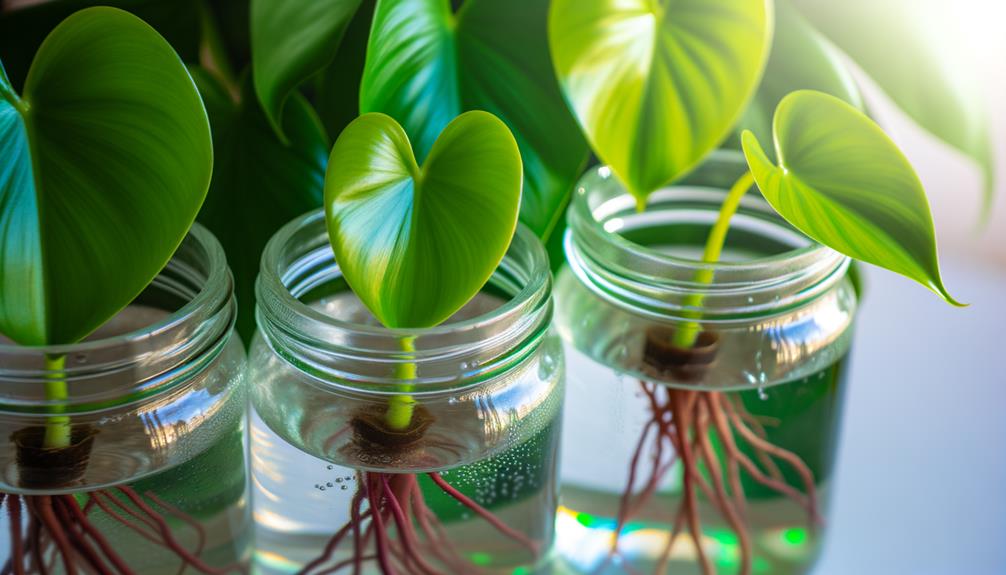
To initiate the rooting process, submerge the cut end of the philodendron cutting in a container filled with clean, room-temperature water, ensuring that at least one node is fully immersed.
For ideal results, follow this systematic approach:
- Container Selection: Use a see-through container to monitor root development and detect any water quality issues promptly.
- Water Quality: Utilize distilled or filtered water to avoid potential contaminants that may hinder root growth.
- Water Level Maintenance: Regularly top up the water to keep nodes submerged, preventing desiccation of the cutting.
- Water Replacement: Replace the water every 5-7 days to maintain oxygen levels and prevent bacterial growth.
These detailed steps will enhance the likelihood of successful Heart Leaf Philodendron propagation.
Optimal Lighting Conditions
Securing optimal lighting conditions is crucial for the successful propagation of Heart Leaf Philodendron cuttings in water. Excellent lighting involves providing bright, indirect sunlight, as direct exposure to intense sunlight can cause photoinhibition, leading to chlorophyll degradation and reduced photosynthetic efficiency.
Position the cuttings near an east-facing window where they receive morning light, or use fluorescent grow lights to simulate natural light conditions. Maintain a light intensity of 200-400 foot-candles, which guarantees sufficient energy for photosynthesis without risking photodamage.
Regularly monitor for signs of insufficient light, such as etiolation or leaf discoloration, and adjust positioning accordingly. Consistent lighting conditions will promote vigorous growth and expedite the rooting process, ensuring healthier plant development.
Monitoring Root Growth
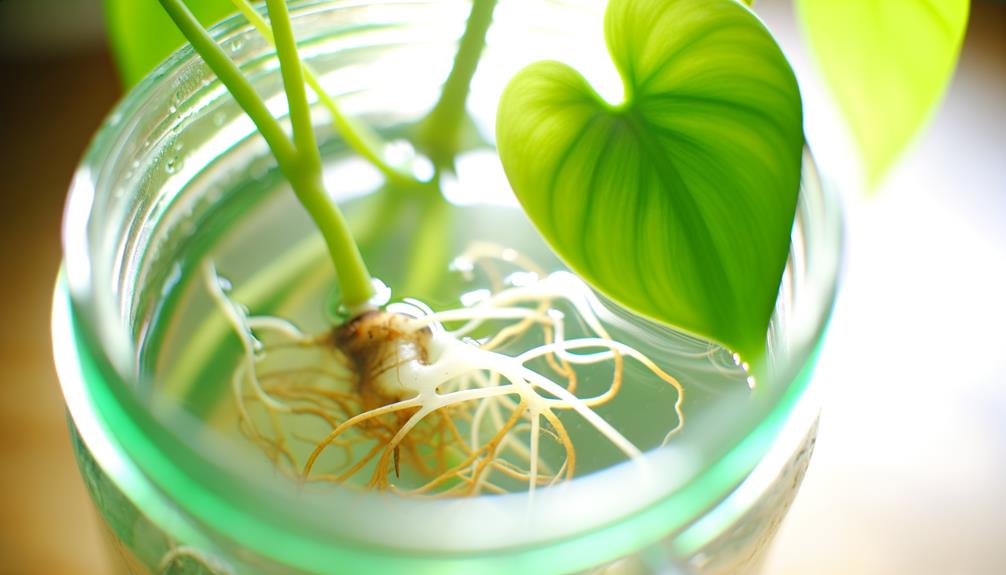
Once ideal lighting conditions are established, it becomes imperative to systematically monitor root growth to guarantee successful propagation of Heart Leaf Philodendron cuttings.
Observing root development involves several critical steps:
- Frequency of Checks: Inspect the cuttings every 5-7 days to verify roots are forming properly and to detect any signs of decay.
- Water Quality: Maintain water quality by changing it every 5 days to prevent bacterial growth, which can hinder root development.
- Root Length Measurement: Measure root length using a ruler; roots should reach 1-2 inches before considering further steps.
- Documentation: Log observations meticulously, noting root length, color, and any anomalies, to track progress accurately.
Consistent monitoring ensures prime conditions for healthy root maturation.
Transferring to Soil
Shifting Heart Leaf Philodendron cuttings from water to soil needs a careful approach to ensure the continued health and growth of the plant. Begin by selecting a well-draining potting blend to avoid waterlogging.
Gently remove the cuttings from water, ensuring minimal disruption to the delicate root system. Place the cuttings into pre-moistened soil, ensuring roots are adequately covered but not compressed. Maintain consistent soil moisture without overwatering during the initial phase.
| Consideration | Details |
|---|---|
| Potting Blend | Well-draining, rich in organic material |
| Root Handling | Gentle removal from water to prevent harm |
| Soil Moisture | Consistently damp, avoid waterlogging |
Monitor the plant for signs of adjustment, adjusting care as needed to promote strong growth.
Troubleshooting Common Issues
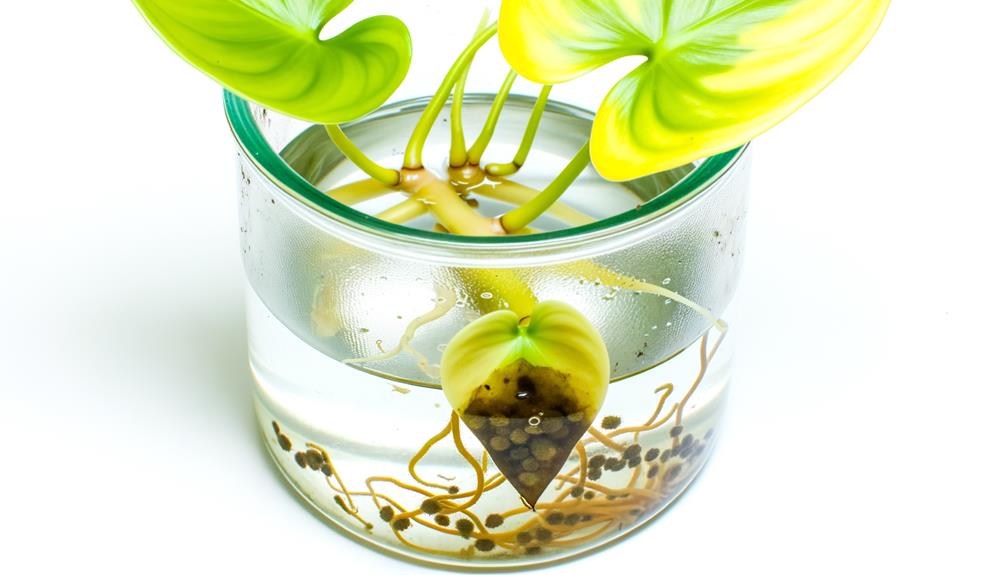
Addressing common issues in Heart Leaf Philodendron propagation in water requires a methodical approach to root rot prevention and identifying causes of yellowing leaves.
Observations should focus on ensuring water changes are frequent to inhibit bacterial growth, and monitoring leaf coloration for signs of nutrient deficiencies or overexposure to light.
Implementing these practices can mitigate propagation failures and promote healthy plant development.
Root Rot Prevention
Preventing root rot in Heart Leaf Philodendron propagation necessitates meticulous attention to water quality, container hygiene, and regular monitoring of root health.
Key practices include:
- Water Quality: Utilize filtered or distilled water to mitigate the risk of pathogens and mineral buildup. Avoid tap water, which may contain chlorine or fluoride detrimental to root health.
- Container Hygiene: Regularly clean propagation containers with a mild bleach solution to eliminate potential contaminants that could lead to root rot.
- Root Health Assessment: Inspect roots bi-weekly for any signs of browning or mushiness, which are early indicators of rot. Immediate action is required if symptoms appear.
- Water Change Frequency: Replace the water every 5-7 days to maintain an oxygen-rich environment, essential for healthy root development.
Yellowing Leaves Causes
Identifying the underlying causes of yellowing leaves in Heart Leaf Philodendron propagation requires a systematic evaluation of several factors including light exposure, nutrient availability, and water quality.
Excessive direct sunlight can lead to chlorosis, where leaves lose chlorophyll and turn yellow. Conversely, insufficient light may also cause similar symptoms due to inadequate photosynthesis.
Nutrient deficiencies, particularly nitrogen or iron, are another common culprit, necessitating regular monitoring and supplementation.
Additionally, water quality is paramount; high levels of chlorine or fluoride can induce phytotoxicity, resulting in yellowing. Ensuring the water is clean and adequately oxygenated will help mitigate these issues.
Consistent observation and timely adjustments are critical in maintaining optimum plant health during the propagation phase.
Do Philodendrons Help Other Plants Propagate
Philodendrons themselves do not directly help other plants propagate. However, they can contribute to a healthy indoor environment that indirectly benefits other plants.
Here’s how:
- Improved Air Quality: Philodendrons are known for their air-purifying qualities. They can remove toxins from the air, creating a healthier environment for other plants to thrive.
- Humidity Regulation: Philodendrons can contribute to higher humidity levels in their vicinity, which can benefit humidity-loving plants. Higher humidity can create favorable conditions for certain plants to root and grow.
- Companion Planting Benefits: While not specifically aiding in propagation, having Philodendrons and other plants together can create a diverse and balanced ecosystem. This can deter pests and create a more stable environment for all plants.
- Microclimate Creation: A well-placed Philodendron can provide shade or support for climbing plants, helping create microclimates that can support the growth and propagation of certain plants.
While Philodendrons do not directly assist in the propagation process of other plants, their presence can create a more favorable environment for other plants to propagate and grow.
Conclusion
To wrap up, mastering the propagation of the heart leaf philodendron in water involves a careful sequence of steps akin to a well-coordinated dance.
Each phase, from selecting robust cuttings to ensuring ideal lighting conditions, serves as a crucial note in this botanical symphony.
Diligent monitoring of root development and timely transfer to soil guarantee the plant’s flourishing future.
Troubleshooting common issues fortifies this process, turning possible setbacks into stepping stones for botanical success.



